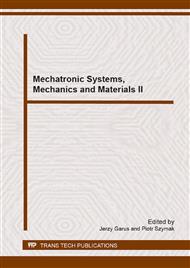p.122
p.130
p.136
p.145
p.156
p.166
p.178
p.186
p.192
Automatically Controlled Anti-Collision Manoeuvre and its Numerical Simulation with Disturbances
Abstract:
The article presents the discussion focused on specific features of the problem of flying objects motion when performing an example of anti collision manoeuvre. To realise this task, the structure of automatic control system with appropriate control laws are proposed. The nature of discussed manoeuvre needs the appropriate numerical method for computing desired values of state variables for subsequent phases of objects motion. These values are obtained adequately for their roles in several phases of motion. Numerical simulations are completed for the aircraft performing the anti collision manoeuvre consisted in abrupt change of yaw. Objects behaviour was tested in case of motion affected by disturbances. The analysis of results obtained by numerical simulations makes possible conclusions on stability of objects motion and control system robustness to assumed kind and level of disturbances.
Info:
Periodical:
Pages:
156-165
Citation:
Online since:
October 2013
Authors:
Price:
Сopyright:
© 2014 Trans Tech Publications Ltd. All Rights Reserved
Share:
Citation:


